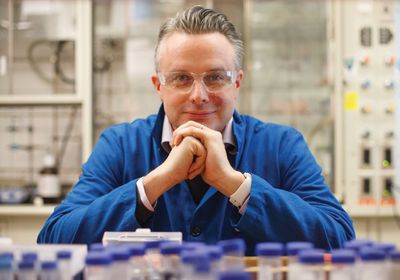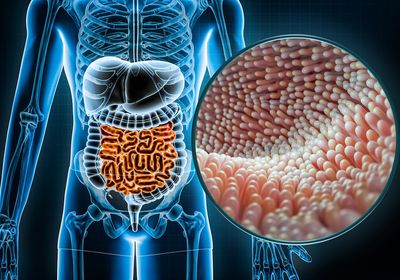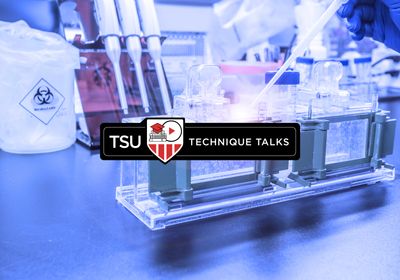ABOVE: Matthew Disney is betting big on the idea that RNA can be drugged almost like a protein. Scott Wiseman
One of the surprises that came out of the Human Genome Project was that only 2% of the genome codes for proteins.1 By contrast, most of it is transcribed into RNA.2 Matthew Disney was a graduate student working on RNA folding at the University of Rochester when the first draft sequence came out in 2001, and it lit a lightbulb in his head. Usually, drugs target proteins, but this discovery suggested that there could be another way.
“It became obvious that a lot of the complexity in humans, both in health and in disease, was dictated by RNA,” he said. “So, I asked myself, could we leverage our ability to predict RNA structure from sequence to find new drug targets?”
This kind of far reaching idea is typical of Disney, according to his long-time collaborator, biochemist Walter Moss from Iowa State University. “His mind is like a hailstorm; he just bombards you with ideas, and somehow he winnows them down to the most important ones,” he said.
In contrast to DNA’s famous double helix, RNA folds in diverse ways, often forming pockets where small molecules could theoretically bind. If it were possible to predict which molecules would bind to which RNA pockets, Disney thought that could hold enormous potential for designing drugs against diseases for which protein-targeting medicines had come up short.
“People thought—and I think still think—that you can’t selectively drug an RNA with a small molecule,” said Disney, who is now based at the The Wertheim UF Scripps Institute, Florida. He remembers a scientific meeting early in his career where luminaries in the field flatly challenged the notion that it could be done at all. Initially, he felt shell-shocked, but he has since realized that they were right to question him. “When I asked my wife to marry me, I didn’t feel like I had to convince her; I said, ‘here’s the data,’” he joked.
We’ve been able to find compounds that bind both coding and noncoding RNA targets.
—Matthew Disney, The Wertheim UF Scripps Institute, Florida
The data supporting his RNA targeting idea simply wasn’t there yet. There were few examples of drugs that worked by interacting with RNA and basically none designed specifically to do so.3 The closest thing was antisense oligonucleotides,4 but they are much larger and usually harder to deliver to patients than small molecules.
Consequently, when he launched his own laboratory at the University of Buffalo, he decided to screen small molecules against libraries of structural RNA features to identify binding patterns. To answer those skeptical questions about selectivity and activity, he included RNA-seq and proteomics in his work.
“We’ve been working on this for almost 20 years in the lab, and we’ve been able to find compounds that bind both coding and noncoding RNA targets,” he said.
Among those compounds were the kind that Disney hoped for: molecules that bound to RNA involved in diseases, such as myotonic dystrophy (DM). DM is caused by an expanded nucleotide repeat in an RNA transcript, making it bunch into a hairpin structure. The hairpin attracts and captures muscleblind-like splicing regulator proteins, which are usually responsible for RNA splicing, and this disrupts muscle development and function. Disney’s group has identified compounds that can bind to those RNA hairpins and displace the stuck proteins.5
Even if a molecule binds well and has good drug-like properties, which often is not the case, fitting into an RNA pocket might not be enough to be effective. “We have been working not just on binders but also on being able to augment the binders with functionality,” Disney said. One of his augmenting inventions is RIBOTAC,6 short for ribonuclease-targeting chimera, which was inspired by proteolysis-targeting chimeras (PROTAC).
A RIBOTAC is a binding molecule coupled to a unit that recruits a ribonuclease, which then breaks down the bound RNA in a process similar to how PROTACs degrade proteins. In a 2020 study,7 he and his team showed that degrading a precursor to an oncogenic microRNA using a RIBOTAC was enough to prevent metastasis in a mouse model of breast cancer. “That was really critical,” said Amanda Hargrove, a chemical biologist at Duke University who has met but never worked with Disney. “Showing that you can recruit proteins to degrade a specific RNA has been a really big step forward for the field.”
Looking back, Disney said that his big ambition has been to convince students and industry that RNA is worth pursuing. “We’re just trying to get people to really think about RNA as a small molecule drug target and, in some sense, we’ve had success in that,” he said.
Moss agreed. “A lot of people thought that the kind of molecules that would be good for binding RNAs wouldn’t have good drug-like properties,” he said. “But Matt has been vindicated, and [the field’s] just growing like gangbusters.”
The data that Disney is so committed to suggest so as well. Companies have spun out, including Disney’s own Expansion Therapeutics, and in 2020, the FDA approved the first small molecule RNA-directed drug.8 Disney partly attributes this progress to testing his compounds in mouse models. “When you get activity there, pharma and others start to pay closer attention. At the end of the day, that’s where we want to be,” he said.
He hopes that the interest will eventually convert into more treatment options for diseases like DM, amyotrophic lateral sclerosis, and others. “I want to go into a world where, when people could use gene therapy or antisense oligonucleotides, they also consider a small molecule.”
If that comes to pass, it will offer a perfect example of how even difficult endeavors can pay off in the long run. “Almost everyone would agree that the low-hanging fruit has been picked [in drug development],” said another of Disney’s collaborators, chemist Brian Paegel from the University of California, Irvine. “Drugging RNA has been an uphill battle, but Matt has really been one of the pioneers, if not the pioneer, doing this.”
References
- International Human Genome Sequencing Consortium. Finishing the euchromatic sequence of the human genome. Nature. 2004;431(7011):931-945.
- Costales MG, et al. How we think about targeting RNA with small molecules. J Med Chem. 2020;63(17):8880-8900.
- Warner KD, Hajdin CE, Weeks KM. Principles for targeting RNA with drug-like small molecules. Nat Rev Drug Discov. 2018;17(8):547-558.
- Rinaldi C, Wood MJ. Antisense oligonucleotides: the next frontier for treatment of neurological disorders. Nat Rev Neurol. 2018;14(1):9-21.
- Guan L, Disney MD. Recent advances in developing small molecules targeting RNA. ACS Chem Biol. 2012;7(1):73-86.
- Tong Y, et al. Programming inactive RNA-binding small molecules into bioactive degraders. Nature. 2023;1-11.
- Costales MG, et al. Small-molecule targeted recruitment of a nuclease to cleave an oncogenic RNA in a mouse model of metastatic cancer. Proc Natl Acad Sci U S A. 2020;117(5):2406-2411.
- FDA press release, 2020.
This article was updated to accurately reflect Matthew Disney's current affiliation







